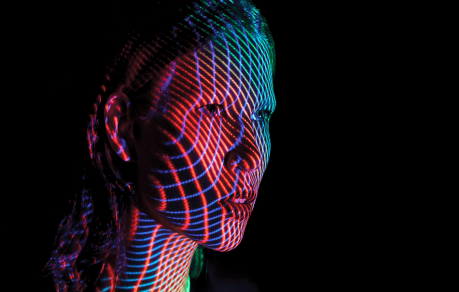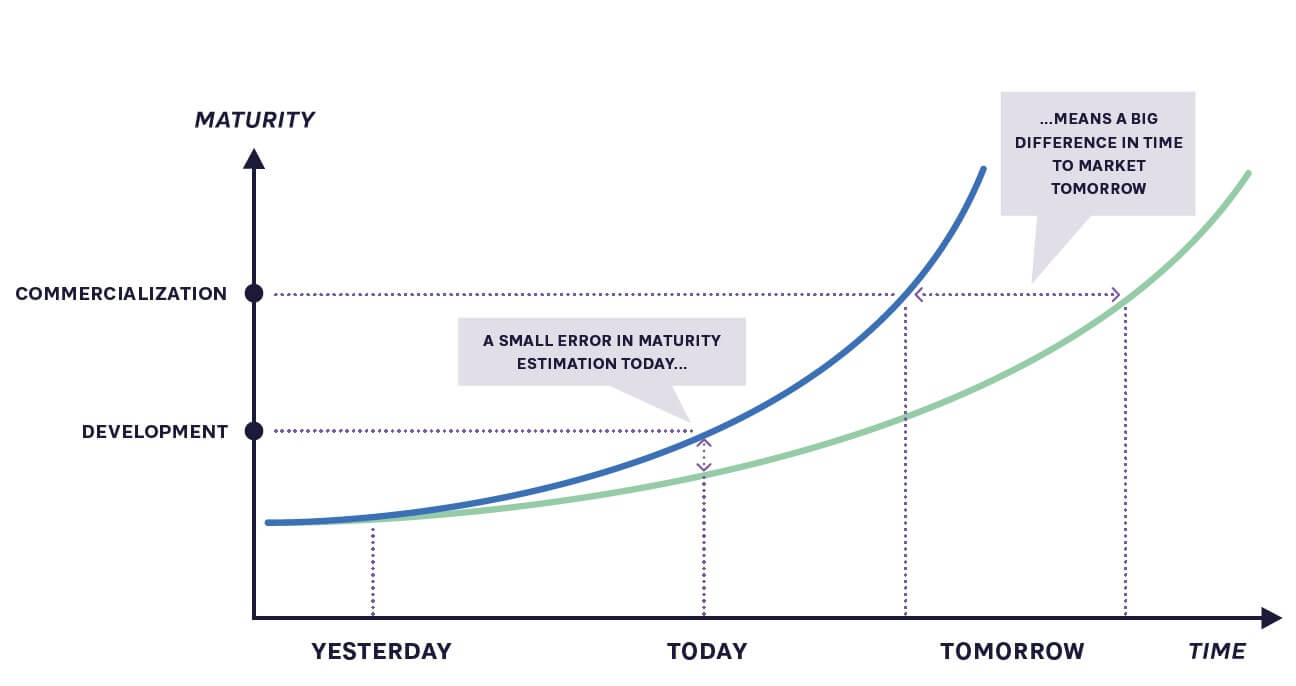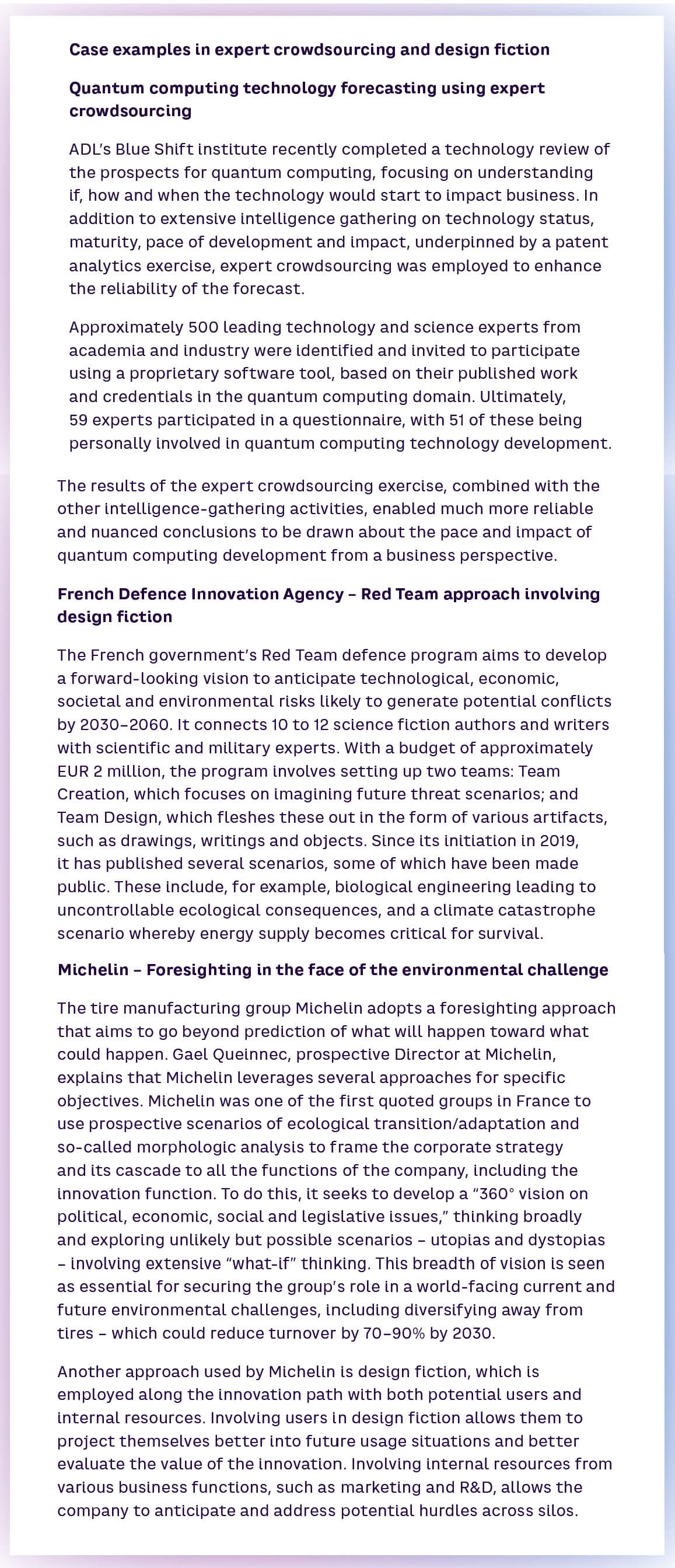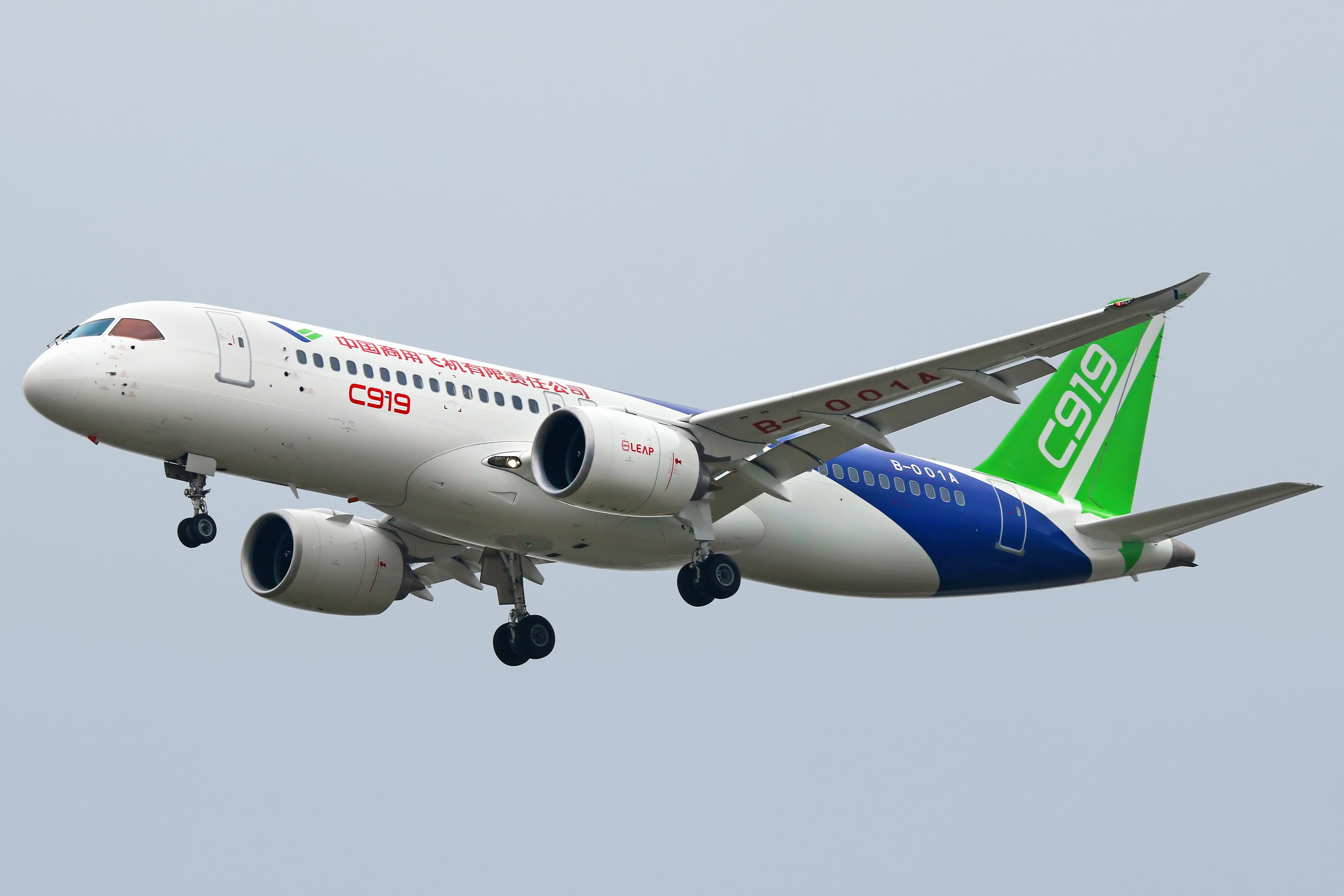11 min read • Technology & innovation management
Take off or trough?
Better technology forecasting using expert crowdsourcing and design fiction

“Prediction is very difficult, especially if it’s about the future.” – Niels Bohr
Back in 2016, amid a wave of optimism, Ford, General Motors and Volkswagen all predicted that driverless cars would be available by 2020 or sooner. In 1970, Marvin Minsky, one of the pioneers of artificial intelligence, predicted that a machine with the general intelligence of a human being would be available within three to eight years. In 2007, when the iPhone was launched, PC Magazine concluded that it was deeply flawed, and that Apple would sell many at first and then sales would plummet. However, since then, 2.2 billion have been sold, and the iPhone accounts for close to half of Apple’s revenues.
Technology development is littered with examples of poor and often wildly inaccurate forecasting. Gartner’s famous Hype Curve recognizes that, in many technology development cycles, an initial period of high expectation is often followed by a trough of disillusionment. Conversely, many technologies develop slowly for extended periods and then suddenly take off – such as the internet. What is undoubtedly true is that the development trajectory is more often bumpy than smooth.
For businesses, this is a problem. Ignoring a potentially disruptive technology can leave a company trailing its competitors if there is a sudden unexpected acceleration. However, investing too much, too soon, can be equally challenging, as Meta is experiencing in its huge gamble on the metaverse. Plenty of technology data and intelligence are around, much of it free, with no shortage of established approaches and frameworks, so why is forecasting still a problem? What can businesses do to get better at technology forecasting?
Common approaches to technology forecasting
Fundamentally, forecasting the future means you have to understand relevant trends that are visible today. Methods, tools and approaches for technology trend intelligence have been around for many years, and can be split into three categories:
-
Scanning: Systematic monitoring and gathering of the latest data, information and intelligence on relevant trends and developments
-
Analytics: Analysis of data on relevant existing science and technology developments, for example, scientific publication (bibiliometrics) and patent data
-
Expert based: A range of approaches that access knowledge, insights and opinions from a variety of internal and external experts on technology trends and futures
Scanning is a central aspect of technology forecasting, and probably the approach that first comes to mind. It should include relevant global and business trends, as well as technology, competitor and market intelligence. If done well, it helps ensure that businesses stay up to date about the latest relevant activities, so they are in a better position to spot important signals that could point to imminent change or disruption. It also helps businesses understand and engage with the evolving ecosystem of players, which is key for developing their own role within it. The obvious limitation is that it largely relies on available published data, which is often of varying quality. Defining the scope boundaries is often difficult, and for many technology fields, there is literally too much to cover.
Analytics of patent data has become increasingly sophisticated with the introduction of digital tools such as AI, machine learning, and visualization tools to enable better trend analysis and interpretation. Challenges such as time lags of often several years between technology development activity and patent filing, skews in the statistics (for example, large volumes of Chinese patents), and differing IP protection policies mean datasets may not be representative. Bibliometrics can reveal impact trends, especially in early-stage research, but its value is mainly in pointing the way for further intelligence gathering, which then still needs to be done.
Expert-based approaches have become increasingly prevalent. The most basic approach is to engage with a limited number of internal and/or external experts to understand their views on technology trends, challenges, uncertainties and likely futures. The long-established Delphi method adds a structured process to the approach, involving two or more rounds of questioning with intermediate analysis and feedback to establish areas of consensus and disagreement. The main advantages of using experts are that they can provide a direct perspective on the future, and often have access to non-published intelligence and interpretation. On the downside, the expert-based approach is difficult to scale. Identifying and recruiting the right experts for a limited interview program is challenging, and the selection process may lead to bias and incompleteness. The traditional expert profile, whereby individuals have deep, narrow expertise, may constrain realistic forecasting perspectives rather than enrich them.
This is also true for registration schemes in which experts register with a broker that sells fee-based interviews on to clients. The experts who wish to be part of such schemes may not always be the best to consult – sometimes they are driven primarily by the need to generate fee income, rather than pursue respective fields of expertise. Moreover, the process can become expensive and impractical for the client if large numbers of interviews are needed regularly to cover a broad field.
Why technology forecasting is especially challenging today
Conventional technology forecasting approaches are increasingly failing to meet the needs of today’s businesses for many reasons:[1]
-
Complexity and convergence: Traditional boundaries between technologies and industries are blurring as a result of convergence; hence, understanding where to look for technology trends and intelligence is increasingly tricky. Technological innovation often occurs precisely at these fuzzy boundaries, with involvement from multiple diverse ecosystem partners. Technology intelligence is further complicated by the plethora of data and opinion that can be found online. Much of this piggybacks on itself, and the original provenance of the source data is no longer clear.
-
Acceleration: New technology development curves are rarely linear. Technologies that ultimately have a disruptive impact tend, instead, to follow an exponential development curve in which pace suddenly increases rapidly with maturity. The acceleration is steep because a breakthrough can lead to a virtuous circle in which success attracts investment and talent, leading to more success. This means a small error in the predicted development “curve fit” could cause a big discrepancy later. (See Figure 1.)
-
Cognition: Executives, like all humans, tend to think linearly, based on mental models of their businesses informed by what has always worked in the past. Experts in narrow fields may be similarly constrained. For technology forecasting, this means key disruptive trends and influences that often arrive laterally from unexpected sources can be missed. Often broader factors, such as social, political and behavioral issues that can greatly affect technological impact, are underestimated due to focus on only technology and economics. If technology scanning and expert interviews are guided by the wrong questions, they will give the wrong answers.

How expert crowdsourcing and design fiction can help
Some companies have significantly improved the quality of their technology forecasting by applying newer methods that aim to overcome these limitations, supplementing the core approaches of scanning, analytics and expert interviewing. The two most significant of these are expert crowdsourcing and design fiction.
Expert crowdsourcing
Crowdsourcing has become an established approach for a variety of tasks, such as raising investment funds, charity fund raising, data gathering, public policy testing, idea generation and problem-solving. Platforms are offered by open innovation service providers such as InnoCentive, NineSigma, and Presans.
Expert crowdsourcing for technology forecasting is a more recent development. It has been estimated that there are 15 million experts around the world across the fields of science, technology and business.[2] Most leave tracks on the web through scientific literature, patents, research center websites, blogs, forums and the like. New software tools supported by data analytics and machine learning are now available,[3] which can build structured expertise maps from unstructured data, based on specific input requests. They can then generate automatic personalized emails to solicit expert participation from the most relevant experts. The process has three steps, as shown in Figure 2.

The key features of the process that are important for its success include:
-
Asking the right questions: The forecast intelligence you wish to gather has to be formulated in a small number (for example, five to 10) of key questions for the experts to answer. These need to be formulated in a way that is clear and unambiguous but does not impose presumptions and implied limits on the scope of the answer. A mix of open and closed questions helps to ensure a good mix of directly comparable data and content-rich opinion.
-
Diversity: The population of experts invited to respond needs to include not just “deep/narrow” experts, but also “diverse/broad” experts whose expertise lies in understanding and uncovering the connections between different fields and finding new perspectives across them. A mix of both technical and geographical backgrounds is also important.
-
Background: It is important to gather key information about each expert’s background, as this helps to spot trends and potential biases in their opinions.
This expert crowdsourcing approach, which involves much larger numbers of experts than conventional expert-based approaches, can help to overcome today’s technology forecasting challenges. For example, it is much easier to gain perspectives that stretch across the fuzzy boundaries of converging technology fields, because experts can be invited across diverse areas of expertise. The “wisdom of the crowd” can be used to help increase the reliability of predictions, especially the key question of when new technologies are likely to mature and impact business. The results of expert predictions can also be sliced and diced in different ways to show differences of opinion between experts with different profiles and backgrounds. There is also less likelihood of bias being introduced than is the case with a limited expert panel. Finally, the approach is low cost, repeatable and essentially automatable, especially versus methods that access registered experts on a fee basis.
Design fiction
The basic idea of design fiction is to use fiction to help explore and understand possible futures, as a way of informing the design of strategies, plans or policies. In the corporate world of hard data, fiction does not normally feature very prominently. In fact, for most companies, fiction would only be employed in long-term strategy development – imagining what the business could look like in 10 years’ time as a way of helping to formulate a strategic vision and ambition.
However, design fiction approaches can also be usefully applied in technology forecasting to help overcome the cognition challenge and better consider the broader factors that may influence the pace of development and impact of new technologies. For example, imagining a future in which brain-computer interface technology is widespread and embedded in everyday life can help to identify a series of issues relating to how the technology would interact with human behavior and impact society. On the plus side, you might be able to put together the main parts of a presentation just by thinking about it, and get your AI bot to complete it. On the downside, your boss could also access what you are thinking. The implications are almost endless.
In practice, effective design fiction approaches for corporate technology forecasting typically proceed as follows:
-
Based on the emerging technology or technology field of interest, consider the implications of a future in which the technology has reached full maturity and is deployed as part of everyday life.
-
Construct one or more fictional accounts of situations involving interaction with the technology. It can help if these fictions are expressed in the present tense, and involve interactions between humans and the technology in plausible, everyday contexts.
-
Use the fictional accounts as a source of discussion and debate, preferably engaging individuals with different types of background, not just technologists. For example, sociologists, psychologists, artists and authors can greatly enrich the content of the exchanges.
-
Consciously consider dystopian implications. These are especially valuable for identifying ethical, social, behavioral or regulatory issues that may be key for determining how and when the technology will impact business and society.
It is important to recognize the differences between design fiction and scenario development as forecasting tools. While design fiction consciously selects a possible future and creates a “realistic” story based on it, scenario development considers the full range of possible factors that could affect the future, and constructs a simplified model of alternative futures involving different outcomes for those factors. The two approaches are complementary.
Insights for the executive – How to improve technology forecasting
In today’s business environment of increasing complexity, convergence, acceleration and uncertainty, companies have to evolve their technology forecasting approaches beyond conventional scanning, analytics and expert interviews. This is especially important in light of the multiple interconnected challenges of green transition. The most successful approaches today recognize key success factors:
-
Conventional technology scanning and analytics need to be complemented with expert-based methods to improve the depth and breadth of perspectives.
-
Experts need to be used the right way. Great care needs to be taken in how they are selected. This means, for example, ensuring that there are enough “diverse/broad” experts, as well as “deep/narrow” experts.
-
Suitable experts need to be engaged in sufficient numbers to avoid bias, using methods that are scalable, repeatable and low cost. The “expert crowdsourcing” approach can be very effective in achieving these aims.
-
Forecasting needs to focus on what “could” happen, rather than seeking to predict what “will” happen. This means a broad-based perspective is essential. Techniques such as design fiction can be useful in achieving this breadth. The future of a new technology is not only affected by technical progress, but also by a range of ethical, social, geopolitical, behavioral and regulatory factors.
-
To enrich the forecasting process, individuals from a range of backgrounds should be considered. Sociologists, psychologists, artists and authors may all have valuable contributions, in addition to technologists and scientists.
Predicting the future will never be easy. However, taking a broader forecasting perspective helps companies recognize better when technologies are likely to take off exponentially – or, conversely, fall into a trough of disillusionment. Companies that do this better than their competitors are likely to enjoy a considerable advantage.
The authors would like to thank Patrice Kefalas, Director of Innovation and Partnerships at Michelin, and Gael Queinnec, Director of Prospective Research at Michelin, for the stimulating discussions on scenarios.
Notes
1. See also our article “Creative thinking for leaders” – Prism September 2022
2. A Guide to Open Innovation and Crowdsourcing (2011)
3. A good example of this is the Expert Search Engine developed by Presans, an Arthur D. Little company

11 min read • Technology & innovation management
Take off or trough?
Better technology forecasting using expert crowdsourcing and design fiction

DATE

“Prediction is very difficult, especially if it’s about the future.” – Niels Bohr
Back in 2016, amid a wave of optimism, Ford, General Motors and Volkswagen all predicted that driverless cars would be available by 2020 or sooner. In 1970, Marvin Minsky, one of the pioneers of artificial intelligence, predicted that a machine with the general intelligence of a human being would be available within three to eight years. In 2007, when the iPhone was launched, PC Magazine concluded that it was deeply flawed, and that Apple would sell many at first and then sales would plummet. However, since then, 2.2 billion have been sold, and the iPhone accounts for close to half of Apple’s revenues.
Technology development is littered with examples of poor and often wildly inaccurate forecasting. Gartner’s famous Hype Curve recognizes that, in many technology development cycles, an initial period of high expectation is often followed by a trough of disillusionment. Conversely, many technologies develop slowly for extended periods and then suddenly take off – such as the internet. What is undoubtedly true is that the development trajectory is more often bumpy than smooth.
For businesses, this is a problem. Ignoring a potentially disruptive technology can leave a company trailing its competitors if there is a sudden unexpected acceleration. However, investing too much, too soon, can be equally challenging, as Meta is experiencing in its huge gamble on the metaverse. Plenty of technology data and intelligence are around, much of it free, with no shortage of established approaches and frameworks, so why is forecasting still a problem? What can businesses do to get better at technology forecasting?
Common approaches to technology forecasting
Fundamentally, forecasting the future means you have to understand relevant trends that are visible today. Methods, tools and approaches for technology trend intelligence have been around for many years, and can be split into three categories:
-
Scanning: Systematic monitoring and gathering of the latest data, information and intelligence on relevant trends and developments
-
Analytics: Analysis of data on relevant existing science and technology developments, for example, scientific publication (bibiliometrics) and patent data
-
Expert based: A range of approaches that access knowledge, insights and opinions from a variety of internal and external experts on technology trends and futures
Scanning is a central aspect of technology forecasting, and probably the approach that first comes to mind. It should include relevant global and business trends, as well as technology, competitor and market intelligence. If done well, it helps ensure that businesses stay up to date about the latest relevant activities, so they are in a better position to spot important signals that could point to imminent change or disruption. It also helps businesses understand and engage with the evolving ecosystem of players, which is key for developing their own role within it. The obvious limitation is that it largely relies on available published data, which is often of varying quality. Defining the scope boundaries is often difficult, and for many technology fields, there is literally too much to cover.
Analytics of patent data has become increasingly sophisticated with the introduction of digital tools such as AI, machine learning, and visualization tools to enable better trend analysis and interpretation. Challenges such as time lags of often several years between technology development activity and patent filing, skews in the statistics (for example, large volumes of Chinese patents), and differing IP protection policies mean datasets may not be representative. Bibliometrics can reveal impact trends, especially in early-stage research, but its value is mainly in pointing the way for further intelligence gathering, which then still needs to be done.
Expert-based approaches have become increasingly prevalent. The most basic approach is to engage with a limited number of internal and/or external experts to understand their views on technology trends, challenges, uncertainties and likely futures. The long-established Delphi method adds a structured process to the approach, involving two or more rounds of questioning with intermediate analysis and feedback to establish areas of consensus and disagreement. The main advantages of using experts are that they can provide a direct perspective on the future, and often have access to non-published intelligence and interpretation. On the downside, the expert-based approach is difficult to scale. Identifying and recruiting the right experts for a limited interview program is challenging, and the selection process may lead to bias and incompleteness. The traditional expert profile, whereby individuals have deep, narrow expertise, may constrain realistic forecasting perspectives rather than enrich them.
This is also true for registration schemes in which experts register with a broker that sells fee-based interviews on to clients. The experts who wish to be part of such schemes may not always be the best to consult – sometimes they are driven primarily by the need to generate fee income, rather than pursue respective fields of expertise. Moreover, the process can become expensive and impractical for the client if large numbers of interviews are needed regularly to cover a broad field.
Why technology forecasting is especially challenging today
Conventional technology forecasting approaches are increasingly failing to meet the needs of today’s businesses for many reasons:[1]
-
Complexity and convergence: Traditional boundaries between technologies and industries are blurring as a result of convergence; hence, understanding where to look for technology trends and intelligence is increasingly tricky. Technological innovation often occurs precisely at these fuzzy boundaries, with involvement from multiple diverse ecosystem partners. Technology intelligence is further complicated by the plethora of data and opinion that can be found online. Much of this piggybacks on itself, and the original provenance of the source data is no longer clear.
-
Acceleration: New technology development curves are rarely linear. Technologies that ultimately have a disruptive impact tend, instead, to follow an exponential development curve in which pace suddenly increases rapidly with maturity. The acceleration is steep because a breakthrough can lead to a virtuous circle in which success attracts investment and talent, leading to more success. This means a small error in the predicted development “curve fit” could cause a big discrepancy later. (See Figure 1.)
-
Cognition: Executives, like all humans, tend to think linearly, based on mental models of their businesses informed by what has always worked in the past. Experts in narrow fields may be similarly constrained. For technology forecasting, this means key disruptive trends and influences that often arrive laterally from unexpected sources can be missed. Often broader factors, such as social, political and behavioral issues that can greatly affect technological impact, are underestimated due to focus on only technology and economics. If technology scanning and expert interviews are guided by the wrong questions, they will give the wrong answers.

How expert crowdsourcing and design fiction can help
Some companies have significantly improved the quality of their technology forecasting by applying newer methods that aim to overcome these limitations, supplementing the core approaches of scanning, analytics and expert interviewing. The two most significant of these are expert crowdsourcing and design fiction.
Expert crowdsourcing
Crowdsourcing has become an established approach for a variety of tasks, such as raising investment funds, charity fund raising, data gathering, public policy testing, idea generation and problem-solving. Platforms are offered by open innovation service providers such as InnoCentive, NineSigma, and Presans.
Expert crowdsourcing for technology forecasting is a more recent development. It has been estimated that there are 15 million experts around the world across the fields of science, technology and business.[2] Most leave tracks on the web through scientific literature, patents, research center websites, blogs, forums and the like. New software tools supported by data analytics and machine learning are now available,[3] which can build structured expertise maps from unstructured data, based on specific input requests. They can then generate automatic personalized emails to solicit expert participation from the most relevant experts. The process has three steps, as shown in Figure 2.

The key features of the process that are important for its success include:
-
Asking the right questions: The forecast intelligence you wish to gather has to be formulated in a small number (for example, five to 10) of key questions for the experts to answer. These need to be formulated in a way that is clear and unambiguous but does not impose presumptions and implied limits on the scope of the answer. A mix of open and closed questions helps to ensure a good mix of directly comparable data and content-rich opinion.
-
Diversity: The population of experts invited to respond needs to include not just “deep/narrow” experts, but also “diverse/broad” experts whose expertise lies in understanding and uncovering the connections between different fields and finding new perspectives across them. A mix of both technical and geographical backgrounds is also important.
-
Background: It is important to gather key information about each expert’s background, as this helps to spot trends and potential biases in their opinions.
This expert crowdsourcing approach, which involves much larger numbers of experts than conventional expert-based approaches, can help to overcome today’s technology forecasting challenges. For example, it is much easier to gain perspectives that stretch across the fuzzy boundaries of converging technology fields, because experts can be invited across diverse areas of expertise. The “wisdom of the crowd” can be used to help increase the reliability of predictions, especially the key question of when new technologies are likely to mature and impact business. The results of expert predictions can also be sliced and diced in different ways to show differences of opinion between experts with different profiles and backgrounds. There is also less likelihood of bias being introduced than is the case with a limited expert panel. Finally, the approach is low cost, repeatable and essentially automatable, especially versus methods that access registered experts on a fee basis.
Design fiction
The basic idea of design fiction is to use fiction to help explore and understand possible futures, as a way of informing the design of strategies, plans or policies. In the corporate world of hard data, fiction does not normally feature very prominently. In fact, for most companies, fiction would only be employed in long-term strategy development – imagining what the business could look like in 10 years’ time as a way of helping to formulate a strategic vision and ambition.
However, design fiction approaches can also be usefully applied in technology forecasting to help overcome the cognition challenge and better consider the broader factors that may influence the pace of development and impact of new technologies. For example, imagining a future in which brain-computer interface technology is widespread and embedded in everyday life can help to identify a series of issues relating to how the technology would interact with human behavior and impact society. On the plus side, you might be able to put together the main parts of a presentation just by thinking about it, and get your AI bot to complete it. On the downside, your boss could also access what you are thinking. The implications are almost endless.
In practice, effective design fiction approaches for corporate technology forecasting typically proceed as follows:
-
Based on the emerging technology or technology field of interest, consider the implications of a future in which the technology has reached full maturity and is deployed as part of everyday life.
-
Construct one or more fictional accounts of situations involving interaction with the technology. It can help if these fictions are expressed in the present tense, and involve interactions between humans and the technology in plausible, everyday contexts.
-
Use the fictional accounts as a source of discussion and debate, preferably engaging individuals with different types of background, not just technologists. For example, sociologists, psychologists, artists and authors can greatly enrich the content of the exchanges.
-
Consciously consider dystopian implications. These are especially valuable for identifying ethical, social, behavioral or regulatory issues that may be key for determining how and when the technology will impact business and society.
It is important to recognize the differences between design fiction and scenario development as forecasting tools. While design fiction consciously selects a possible future and creates a “realistic” story based on it, scenario development considers the full range of possible factors that could affect the future, and constructs a simplified model of alternative futures involving different outcomes for those factors. The two approaches are complementary.
Insights for the executive – How to improve technology forecasting
In today’s business environment of increasing complexity, convergence, acceleration and uncertainty, companies have to evolve their technology forecasting approaches beyond conventional scanning, analytics and expert interviews. This is especially important in light of the multiple interconnected challenges of green transition. The most successful approaches today recognize key success factors:
-
Conventional technology scanning and analytics need to be complemented with expert-based methods to improve the depth and breadth of perspectives.
-
Experts need to be used the right way. Great care needs to be taken in how they are selected. This means, for example, ensuring that there are enough “diverse/broad” experts, as well as “deep/narrow” experts.
-
Suitable experts need to be engaged in sufficient numbers to avoid bias, using methods that are scalable, repeatable and low cost. The “expert crowdsourcing” approach can be very effective in achieving these aims.
-
Forecasting needs to focus on what “could” happen, rather than seeking to predict what “will” happen. This means a broad-based perspective is essential. Techniques such as design fiction can be useful in achieving this breadth. The future of a new technology is not only affected by technical progress, but also by a range of ethical, social, geopolitical, behavioral and regulatory factors.
-
To enrich the forecasting process, individuals from a range of backgrounds should be considered. Sociologists, psychologists, artists and authors may all have valuable contributions, in addition to technologists and scientists.
Predicting the future will never be easy. However, taking a broader forecasting perspective helps companies recognize better when technologies are likely to take off exponentially – or, conversely, fall into a trough of disillusionment. Companies that do this better than their competitors are likely to enjoy a considerable advantage.
The authors would like to thank Patrice Kefalas, Director of Innovation and Partnerships at Michelin, and Gael Queinnec, Director of Prospective Research at Michelin, for the stimulating discussions on scenarios.
Notes
1. See also our article “Creative thinking for leaders” – Prism September 2022
2. A Guide to Open Innovation and Crowdsourcing (2011)
3. A good example of this is the Expert Search Engine developed by Presans, an Arthur D. Little company




